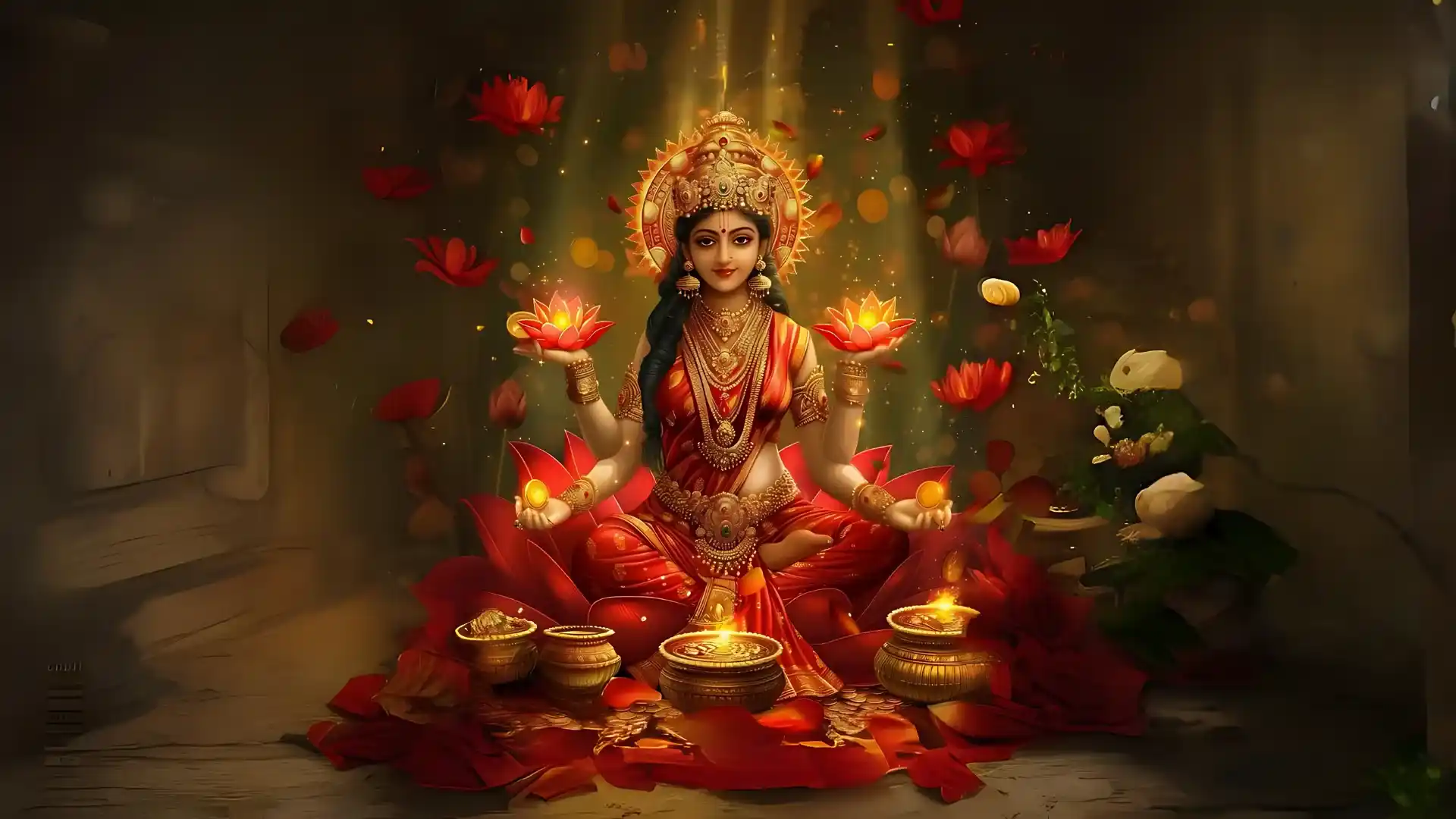What is Beeja or Beej (Shreem)?
Beeja means seed. A seed is tiny but it encapsulates an entire tree. Similarly, beeja mantras are sacred sound vibrations which contain the essence of the deity. Sanatana dharma has many deities.
Each deity has a unique nature, just as each flower is fragrant in a different way. Hence, beejas are an essential ingredient in the formation of mantras. A cautionary note- It is important to take initiation from an authorized guru, before you can think of chanting a Beeja Mantra. Else the chanting may activate chakras incoherently, resulting in insanity.
What is the Shreem Beeja Mantra
Shreem is the Bija mantra of Goddess Lakshmi. Lakshmi devi is the consort of Lord Vishnu. She sits near His Lotus feet engaged in pressing (serving) His feet. The mantra is also associated with the third eye or Ajna chakra.

Usually, beejas are hard to translate, yet it is easy to understand the Shreem Mantra.
We utter the word Shree to show respect. While ‘m’ refers to inherent divinity within Shree (The Satvika Form of the Divine Mother). Hence the word Shreem means paying homage to divinity. Shree also symbolizes Lakshmi Devi. Lord Vishnu bears the Shri Vatsa mark on his chest.
A Detailed Understanding of the Shreem Mantra
We can break the Shreem mantra into four parts.
Sha, means Goddess Lakshmi. Ra, symbolises wealth, Ee stands for contentment while “m”, represents Brahman, the Ultimate Truth. The Shreem mantra can be chanted with a longer mantra or it can be chanted singly. Uttering Shreem invites wealth and prosperity to your doorstep. Know that Lakshmi devi is not just about wealth and prosperity.
When seekers search for Lakshmi Beej Mantra in English, they are looking for a mantra that is both easy to chant and deeply powerful. The word “Shreem” itself is enough,simple, sweet, and potent. It can be chanted alone or as part of longer Lakshmi mantras. For example, “Om Shreem Mahalakshmyai Namaha” is a beautiful full version for those seeking deeper spiritual immersion. Even repeating just “Shreem” with love and purity in English-scripted form yields immense results.
She is an ocean of motherly love who heals one’s emotional scars. She grants peace of mind which is rare to achieve today. Also we imbibe qualities such as gratitude and learn to appreciate the goodness in our lives.
The Lakshmi Devi Beej Mantra,Shreem,is more than just a sound. It is a divine vibration encoded with the mother’s nourishing grace. When chanted with devotion, it removes inner poverty,feelings of lack, doubt, and anxiety,and fills the heart with Shakti (spiritual energy). Whether you are a householder seeking harmony or a businessperson striving for balance, invoking the Lakshmi Devi Beej Mantra attracts sattvik (pure) wealth and uplifts the soul simultaneously.
A question often asked by seekers is, What are the Om Shreem Mantra benefits in practical life? This sacred sound not only enhances material abundance but also purifies inner perception. Many report feeling a deep sense of inner peace, along with improved relationships and intuitive decision-making, when chanting “Om Shreem.”
It connects you directly to the frequency of Lakshmi Devi and subtly shifts your aura to magnetize wealth and goodwill. Thus, the Om Shreem Mantra benefits go far beyond money,they include emotional healing, energetic alignment, and heart-based fulfillment. Before diving deep into the benefits of Shreem mantra, let us explore the Exclusive Kanakadhara Yantra.
Kanakadhārā Yantra: The Geometric Embodiment of Śrī Ādi Śaṅkara’s Golden Invocation
The Kanakadhārā Yantra is the sacred śrīcakra-anukāraṇa (sacred geometrical analogue) of the luminous Kanakadhārā Stotram revealed by Jagadguru Śrī Ādi Śaṅkarācārya. This stotram, renowned for invoking a suvarṇa-varṣa (shower of gold), was born of pure compassion,and the yantra carries that same divine frequency in geometric stillness.
Rooted in deep mantra-yantra-tantra saṅghaṭana, this yantra becomes fully activated through specific mantrās:
Kanakadhārā Stotram – all 21 verses as a flowing stream of grace (anugraha-dhārā).
Bīja Mantra – “ॐ श्रीं ह्रीं क्लीं ऐं” – the core śakti-sañcāra (energy transmission syllables).
Mahālakṣmī Mantra – “ॐ श्रीं महालक्ष्म्यै नमः” – invokes the benevolent goddess of śrī (auspiciousness).
Siddha Mantra – “ॐ श्रीं ह्रीं क्लीं ऐं कमलवासिन्यै स्वाहा” – a tantric mantra calling the kāmadhenu-like flow of Laxmī seated in the lotus.
This yantra is not a decorative artifact but a śabda-tanmātra yantra-rūpa, a form that translates divine sound into geometric energy. When chanted upon during brāhma-muhūrta, on Śukravāra (Fridays), or during Pūrṇimā and Varalakṣmī Vratam, the yantra’s kārmic granthi-bhedana śakti (power to dissolve karmic knots) is most active.

Just as Śrī Ādi Śaṅkara’s verses softened the heart of Mahālakṣmī to bestow abundance upon a destitute brāhmaṇa-patnī, this yantra softens the inner resistances of the jīva and opens the nāḍīs to receive ananta-saumya-dhārā,an infinite stream of gentle divine grace. Each mantra echoes into the padma-kośas (lotus petals), trikoṇas (triangles), and bindu-sthāna (point of unity), vibrating into the sūkṣma-deha of the practitioner and aligning them with the śrī tattva,the essence of sacred prosperity.
Śrī-Kanakadhārā Yantra Phala: The Subtle Blossoming of Dhārmika Lakṣmī
The Kanakadhārā Yantra is not a charm to demand wealth,it is a sacred śrī-yantra-janya mārga, a luminous path that opens the heart to anugraha (divine grace) and aligns the seeker’s inner being with the flow of dhārmika sampatti (righteous abundance). When approached with śraddhā (devotional sincerity) and niyama (spiritual discipline), this yantra slowly begins to unwind the karmic knots that choke the natural flow of prosperity.
Its resonance touches the arjana-śakti,the subtle inner power to attract rightful livelihood,and heals deeply embedded patterns of abhāva-saṁskāra (scarcity conditioning). Especially in lineages where dāridrya (poverty) has lingered despite effort, the yantra gently reweaves a new karmic permission to receive.
Householders have experienced not only an outer arthika-vṛddhi (financial upliftment), but also a shift in their citta-vṛtti (mental impressions): fear dissolves, greed calms, and a graceful contentment takes root. The household becomes a space of saumya-lakṣmī tattva,a feminine, nourishing force that uplifts without agitation.
When the yantra is pratiṣṭhita on Śukravāra (Fridays), especially with kanakapadmāḥ (golden pink lotuses), ghṛta-dīpa (lamp of cow’s ghee), and the recitation of the Kanakadhārā Stotram, the tanmātrika śakti embedded in its lines becomes fully alive.
Ṛṇa-mukti (freedom from debt), kārya-siddhi (fulfillment of righteous goals), pitṛ-kṛpā (ancestral blessings), and āyur-aiśvarya-sampatti (long life with graceful prosperity) are among the natural unfoldings,not as transactions, but as consequences of inner sattva-pūrṇa alignment.
The yantra does not bribe divinity,it harmonizes you with śrī tattva, so that what you seek no longer runs from you.
Kānti-Mayī Śrī-Kanakadhārā Yantra Racanā: The Divine Blueprint of Golden Flow
The Śrī-Kanakadhārā Yantra is a luminous divya-racanā,a sacred geometric composition that encodes the divine intent of Mahālakṣmī in layered vibrational forms. It is not merely a drawing; it is a tantra-siddha cakra-maṇḍala, alive with śabda-brahma,the subtle sound-current of the mantras it houses.
At the heart of this yantra lies the bindu, the śakti-pīṭha,the radiant, unmanifest center where Mahālakṣmī resides as śrī-prakāśa. From this point emanates the golden flow of divine compassion, wealth, and nourishment. Surrounding the bindu is the inverted trikona, the kāma-kalā trikoṇa,a threefold channel of icchā-śakti, jñāna-śakti, and kriyā-śakti. This downward-facing triangle, adorned with a subtle dot, symbolizes the descent of grace into material existence.
The yantra then unfolds into dvaya-padmāvalī,two concentric kamala-valayas (lotus garlands). The inner lotus of eight green petals serves as the aṣṭa-lakṣmī-prabodhaka cakra, with seed syllables like “hṛīṃ,” “śrīṃ,” and “klīṃ” inscribed within. These petals vibrate with qualities of wealth, nourishment, courage, and auspiciousness.
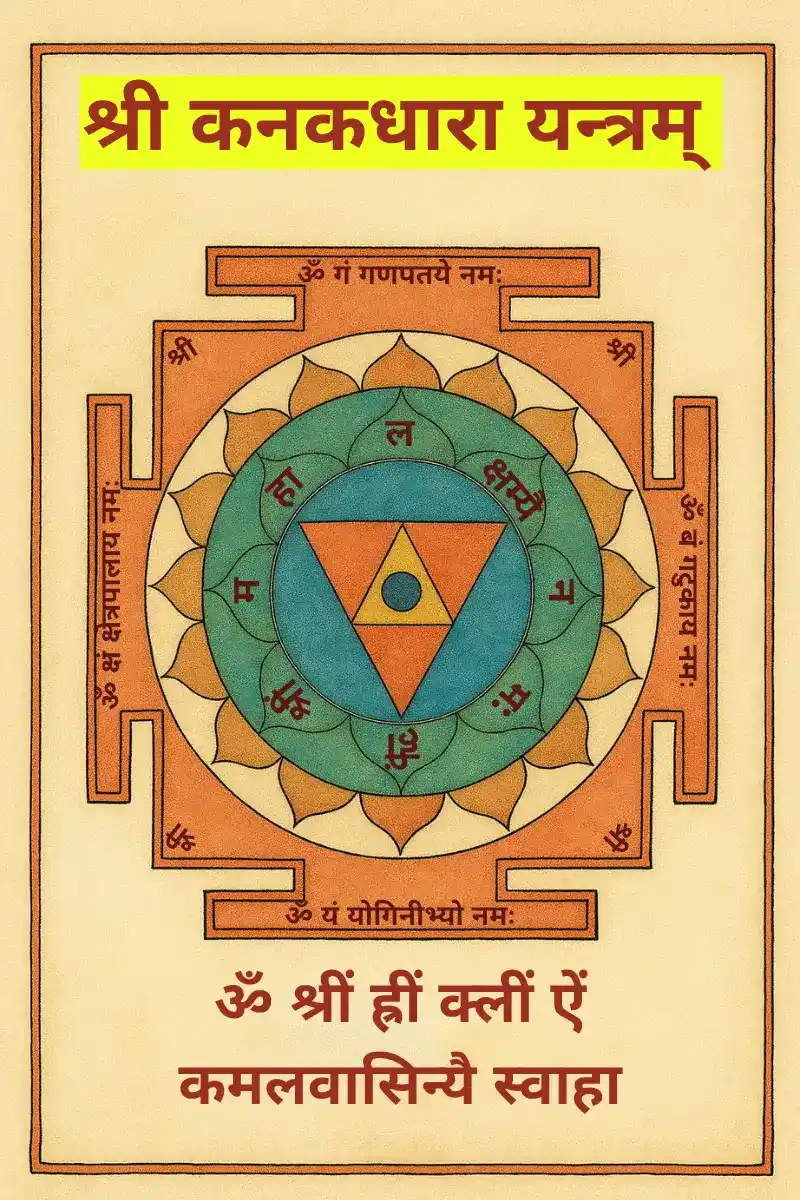
Encasing this is the sixteen-petaled outer lotus, golden in hue, which generates a field of sāmarthya,the energetic ability to receive divine abundance. It refines the sūkṣma-indriyas (subtle senses), preparing the devotee to hold the blessings invoked.
The entire yantra is enclosed within a bhūpura,a square with four cardinal gateways. These dvāra-sthānas are inscribed with protective mantras invoking Gaṇeśa, Yoginīs, and Rakṣaka Devatās. The bhūpura grounds the yantra’s energies into bhū-loka (earth plane), ensuring its force is both etheric and tangible.
Each color chosen in this yantra speaks in rasa,turquoise for inner expansion, saffron for karmic purification, gold for luminous prosperity, and deep blue for mystic depth. The tīkṣṇa-rekhāḥ (sharp lines) represent divine resolve, while the komala-dala (soft petals) evoke śrī-saumya-śakti,the gentle maternal presence of Lakṣmī.
Altogether, the Kanakadhārā Yantra becomes a living interface between the aspirant and Mahālakṣmī Tattva, balancing the puruṣa and prakṛti, the effort and the grace, in sacred geometry.
Śrī-Kanakadhārā Yantra Gāṇita-Rahasya: The Mystic Geometry of Prosperity Embodied
The Śrī-Kanakadhārā Yantra is not a random artistic pattern,it is a living tantric-citra, a śāstra-maya saṅkalpa etched in sacred proportions. Each geometric layer within it functions as a precise śakti-yantra, calibrated to influence the prāṇa-vṛtti (energetic movement) of the sādhaka and refine the sūkṣma-śarīra (subtle body).
At the very hṛdaya of this yantra lies the bindu, the mahālakṣmī-sannidhi-sthāna,a radiant point where śrī-prakāśa condenses. When meditated upon, this bindu opens the sahasrāra-cakra, aligning the seeker with the divya-nidhis (celestial treasures) that dwell beyond thought and form. It becomes the crown-gate of descent for golden consciousness.
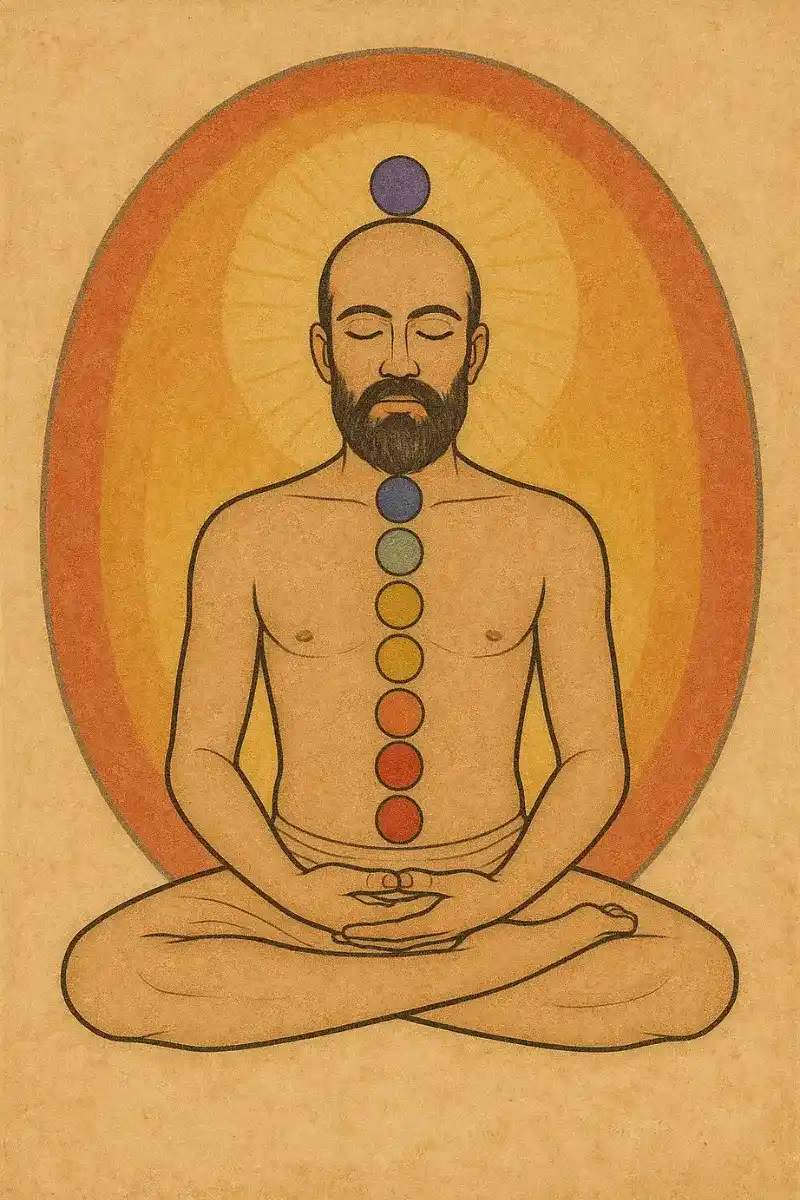
Surrounding it, the downward-pointing kāma-kalā trikona acts as a śakti-kṣetra,drawing the subtle śrī-śakti from the higher realms into the manifest world. This triangle harmonizes prāṇa and apāna, integrating aspiration with embodiment. It is here that abundance transforms from idea to experience.
The padma-valaya,inner and outer lotus circuits,regulate cakra-śuddhi and aura-sañcāra. The eight inner petals resonate deeply with the maṇipūra, anāhata, and svādhiṣṭhāna cakras, dissolving arthika bhaya, ajñāna kleśa, and dāridrya doṣa. The sixteen outer petals create an energetic halo of receptivity, where śraddhā (faith), santoṣa (contentment), and daivī sampatti (divine virtues) blossom.
The bhūpura, with its four gateways, is the pṛthvī-bhūta-granthī, the anchoring frame that brings subtle resonance into material manifestation. Without it, the energies invoked would remain abstract or float in manas-tattva. The bhūpura seals the circuit, ensuring the śakti-vṛtti grounds fully into bhū-loka.
When mantras such as “śrīṃ, hṛīṃ, klīṃ, aiṃ” are recited while meditating on this yantra, the sacred geometry forms an inward-spiraling vortex,drawing mantra-vibration into a focused current. Instead of dissipating, the nāda (sound-energy) circles back through the bindu, illuminating the aura with a hema-prakāśa,golden brilliance that nourishes and sanctifies the seeker from within.
In essence, this yantra becomes a mantra-sādhana-pīṭha,a throne of sacred sound and form,where the aspirant sits in stillness and is reshaped by divine symmetry.
Śrī-Kanakadhārā Yantra Prāṇa-Pratiṣṭhā: Mantric Awakening of the Golden Yantra
The Śrī-Kanakadhārā Yantra is not a passive symbol,it is a śabda-brahma rūpa, a form encoded with dormant cosmic intelligence awaiting activation. To transform this yantra into a living śakti-mūrti, it must be awakened through mantra-japa, bhāva-yukta pūjā, and ideally, Guru-upadiṣṭa dīkṣā (initiation from a realized teacher). Only then does the yantra begin to pulse with the kanakāmṛta-dhārā,the golden stream of Lakṣmī’s grace.
The foundational bīja mantrās that stir the subtle layers of the yantra are:
ॐ श्रीं (Śrīṃ) – the very essence of Śrī Tattva, invoking auspiciousness and plenitude
ॐ ह्रीं (Hrīṃ) – the māyā-bīja, invoking divine radiance and inner magnetism
ॐ क्लीं (Klīṃ) – the kāma-bīja, unlocking attraction and fulfillment
ॐ ऐं (Aiṃ) – the vāk-bīja, channeling Sarasvatī’s wisdom to align wealth with purity
ॐ रीं (Rīṃ) – a rare bīja that stirs the latent rasa of desireless joy and softens the karmic field
The primary kārya-preraṇa mantra for this yantra is:
ॐ श्रीं ह्रीं क्लीं ऐं
कमलवासिन्यै स्वाहा॥
This siddha-mantra invokes Mahālakṣmī as the one seated in the cosmic lotus, bestowing not only material sampatti but also inner equilibrium and grace.
To deepen this activation, the Mahālakṣmī Gāyatrī Mantra may be recited with devotion:
ॐ महालक्ष्म्यै च विद्महे
विष्णुपत्न्यै च धीमहि
तन्नो लक्ष्मीः प्रचोदयात्॥
This mantra aligns the buddhi-tattva (intellect) of the sādhaka with the divine frequency of Lakṣmī, allowing for a pure channel of invocation.
The yantra should be awakened on a Śukravāra (Friday), ideally during brāhma-muhūrta or twilight. The prāṇa-pratiṣṭhā includes offering tila-dīpa (sesame oil lamp), gandha-puṣpa (fragrant flowers), and haldi-kumkum at the bhūpura-dvāras. Mantra-japa in counts of 108 or 1008 daily creates a mantra-garbha (mantric womb) within the yantra, making it a living temple.
If Guru Deekṣā is not yet received, one may still honor the yantra through weekly Laxmī-pūjā on Fridays, recitation of the Kanakadhārā Stotram, and offering a silent heart full of śraddhā,for in the realm of śrī-tattva, sincerity is the true wealth.
Śrī-Kanakadhārā Yantra Nirmāṇa-Vidhāna at YantraChants.com: A Sacred Transmission, Not a Product
At yantrachants.com, the preparation of the Śrī-Kanakadhārā Yantra is approached not as merchandise, but as prasāda,a sacred spiritual transmission infused with śuddha-saṅkalpa. Each yantra is handcrafted with reverence on authentic Bhoja Patra, following the śāstrīya paddhati preserved through paramparā-jāta brāhmaṇa-kula (Vedic lineage-based priesthood).
The nirmāṇa-krama begins with pūrva-saṁskāra,a ritual cleansing of the Bhoja Patra during brāhma-muhūrta, when the etheric currents are most sattvic and receptive. The lekhana (inscription) of the sacred geometry and bīja mantras is done only during śubha-hora ruled by Śukra or Candra, invoking saumya-lakṣmī tattva and enhancing the yantra’s inner glow.
Herbal nāṭya-rasa inks are meticulously prepared from kuṅkuma (saffron), haridrā (turmeric), gomūtra-treated minerals, and subtle oils,creating a living script that carries vibrational intelligence. This is not ink,it is aushadhī bindu, where mantra meets medicine.
Once inscribed, the yantra undergoes yantra-sthāpanam with puṣpa-ārchana, dhūpa-samarpana, and naivedya offering to Mahālakṣmī. Then begins the śakti-āveśa,energization with 108 recitations of the Kanakadhārā Stotram, invoking golden rays of divine compassion and prosperity to enter the trikoṇa, padma-valaya, and bindu of the yantra.
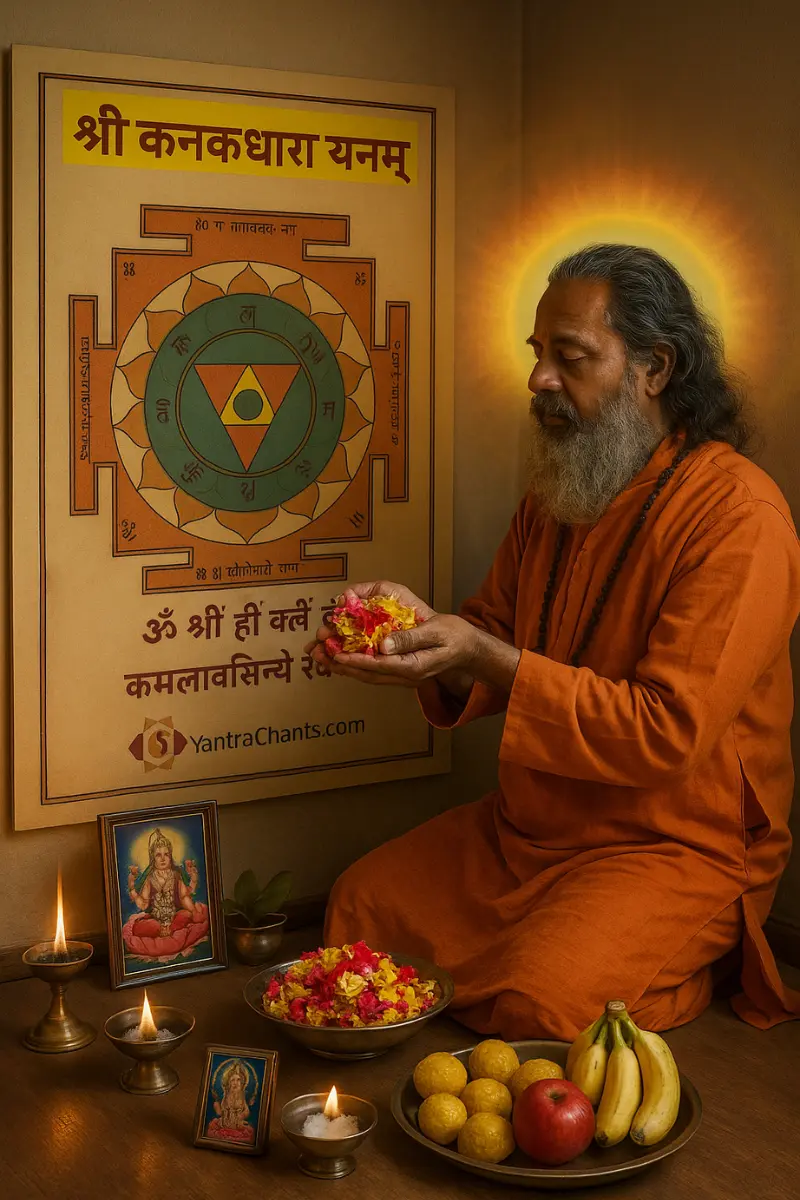
The final saṅrakṣaṇa (sealing) is done using gau-ghṛta (cow ghee) and candana paste, while the nāma (name) of the intended recipient is silently meditated upon by the mantra-kartā. This aligns the yantra’s prāṇa with the receiver’s karmic field.
The yantra is then gently wrapped in red silk cloth, infused with maṅgala-śakti, and a tulasī-dala (holy basil leaf) is placed within,symbolizing purity, devotion, and divine fragrance.
What is dispatched is not a product,it is a living śrī-vigraha carrying the intention of grace, prepared through the ancient science of mantra-tantra-yantra saṅghaṭana. When received with reverence, it becomes a śrī-pīṭha in the devotee’s life,an anchor of mahālakṣmī-anugraha through sacred form.
Some Immediate Benefits of the Shreem Mantra
So it becomes very important to be physically and mentally pure. We must have heard the famous saying “Health is Wealth”. Lakshmi Devi’s blessings hold true here. You develop a powerful personality and spread your radiance wherever you go. People facing financial insecurities greatly benefit from this beeja mantra.
You become sensitive to negative influences and pull away from such association. n this competitive world, you stand out like a diamond, being able to achieve your goals and attract clients if you are a salesman. Shreem mantra gives businessmen the Midas touch to build a fortune.
Among all the wealth-attracting mantras, the Shreem mantra is often revered as the most effective money mantra. But it is not just about hoarding or chasing wealth. Instead, it teaches one to become a vessel of dharmic abundance,wealth that flows in, nourishes the family, helps others, and moves with grace. A true money mantra like “Om Shreem” doesn’t just bring coins,it brings calm confidence, clarity of purpose, and divine timing.

In today’s world of unemployment, the mantra opens new avenues for financial security. It shall lessen the burden of debts too. Shreem mantra is like a battery surcharging you with positivity. The mantra improves concentration and deals with your mental blocks.
For those wondering about Om Shreem Namah benefits, know that this variant of the mantra further refines the energy. The addition of “Namah” adds an element of surrender and humility, which pleases Lakshmi Devi immensely. The mantra then becomes a full salutation,not just a vibration of attraction but of reverence. It softens ego, heals self-worth issues, and invokes the mother’s blessings in ways beyond imagination.
Also, it builds a magnetic aura around you impressing the onlookers. These are all the material benefits. However, even Shaktas can meditate on this beeja since it is a Shakti beeja mantra. Those who chant for the pure motherly love of the goddess, transcend all mundane material problems and attain the highest bliss.
A powerful companion to the Shreem mantra is the Om Hrim Hrim Hrim Swaha mantra, especially for advanced sadhakas. While “Shreem” invokes Lakshmi, “Hrim” is the bija of divine manifestation and inner awakening. When used together under Guru’s guidance, these mantras cleanse the inner field and empower the seeker to handle the energy responsibly. The combined vibration of Shreem and Hrim uplifts not just finances, but consciousness itself.
Intention drives the Power of the Mantra
The Mantras cannot yield results if not backed by pure intentions, especially Powerful Beejas like the Shreem Mantra. Hence one should understand the secrets of Beeja Mantra from an authentic, God-realized Guru. Then one must purify one’s heart by following a preliminary sadhana program from such a Guru.
Care to be taken while Chanting Beeja Mantras
Then the sadhaka or devotee sould follow instructions without exclusions, omissions and obedience. Thus one should make oneself prepared for becoming eligible for chanting Beeja Mantras. Then, if Guru is satisfied alone, one should chant the Beeja. Otherwise, one should avoid Beeja mantras at all costs. Otherwise, it becomes difficult to manage the various positive and negative manifestions of Beeja Mantras.
Thus always to chant the beeja mantra with a pure intention. Material benefits only come when one first becomes desireless. Such is the nature of any Mantra in Kaliyuga. Serving mother Lakshmi should be the ultimate aim.
The goddess tests the devotee at every stage of the sadhana. Share your experiences with the guru for guidance. You can chant the beeja mantra at any time of the day, but consult your Guru before taking up any step with respect to Beeja Mantras.
Process of Chanting Beeja Mantras
Stick to a vegetarian diet, without onion, garlic and mushrooms, as mother Lakshmi is a Satvik goddess. Sit in Padmasana or Sukhasana, or as your body permits. Maintain proper posture to improve blood flow.
To start with, chant the beeja mantra 108 times at one stretch. For more benefits, take a sankalpa as directed by your guru. To know how to take Sankalpa.
Use a Tulsi mala or a counter while meditating on the lotus feet of Lakshmi devi. It is recommended to chant Bija mantras in the mind. But it is also advisable to chant the Shreem Mantra on a Lotus Bead Mala. But before taking a call, consult your Gurudeva.
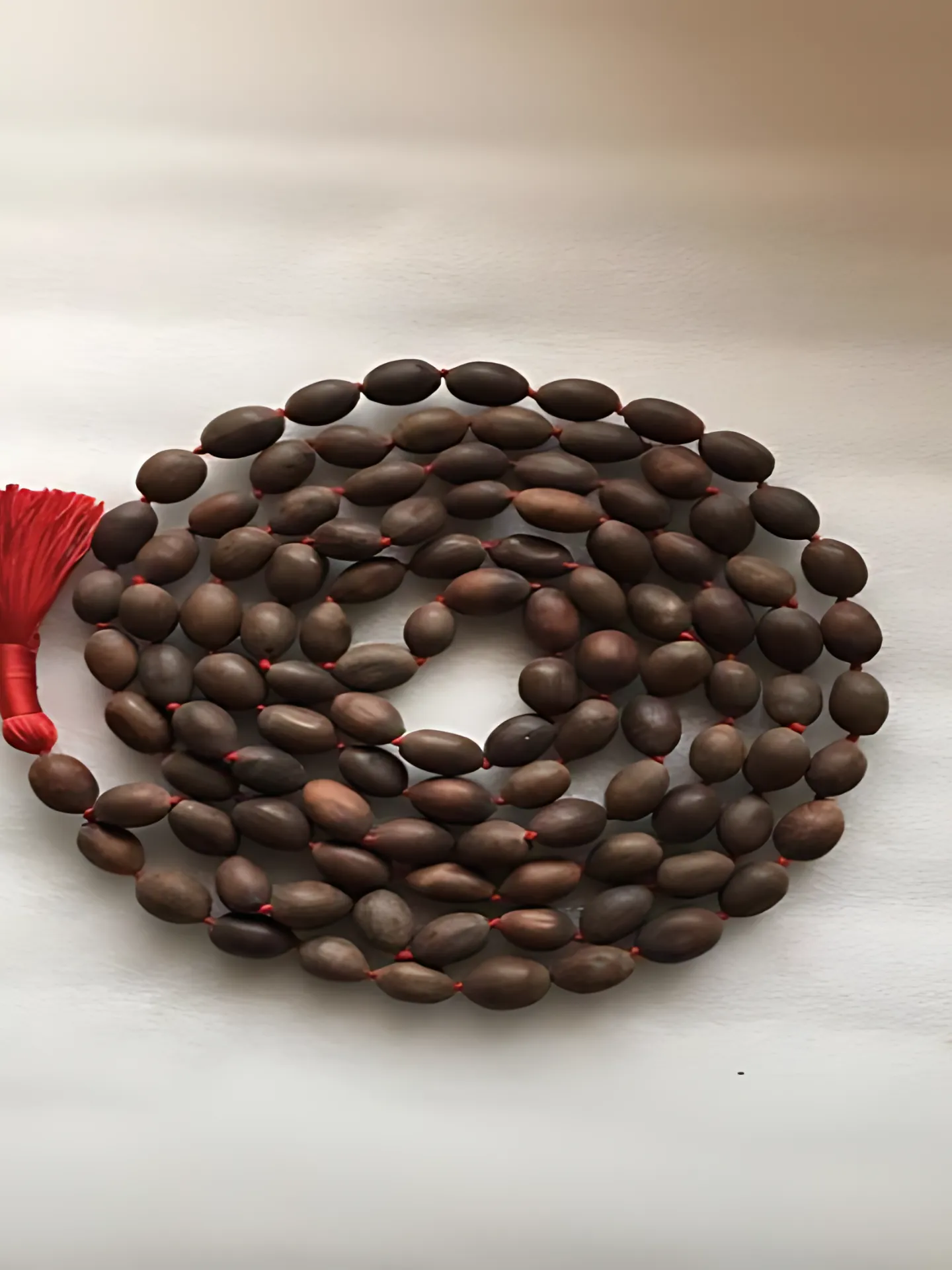
While chanting, naturally the mind shall drift away. Some common side effects are sleep and undesirable thoughts from the unconscious plane. In such a case, the seeker must cultivate awareness and be truthful to one’s intention. Increase your rounds to show your sincerity to the deity.
With divine grace, you shall easily surmount the challenges of life, and witness approaching fortune.
Receive this sacred yantra to ignite divine momentum in your stalled ventures. Inquire now for energization aligned to your purpose.

